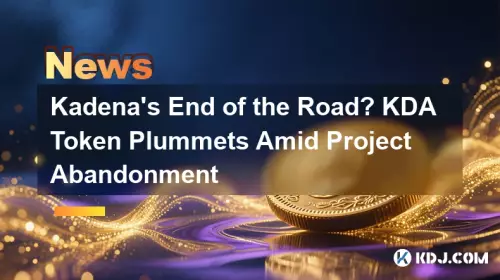 |
|
 |
|
 |
|
 |
|
 |
|
 |
|
 |
|
 |
|
 |
|
 |
|
 |
|
 |
|
 |
|
 |
|
 |
|
Cryptocurrency News Articles
On-Chain Governance: From Primitive Games to Futarchy's Predictive Wisdom
Mar 28, 2024 at 12:22 am
On-chain governance, despite its potential for complex protocols, faces challenges such as Sybil attacks. Futarchy, proposed by Robin Hanson, introduces prediction markets to determine decisions based on the organization's welfare measure, incentivizing participants to make predictions and rewarding them accordingly. By betting on the future value of the welfare measure contingent on specific policies, futarchy aims to remove emotion and facilitate rational decision-making based on the "wisdom of the crowd." Implementing prediction markets requires automated market makers (AMMs) to address liquidity issues, and Gnosis's CFMM implementation of the LMSR balances liquidity and prediction accuracy.

On-Chain Governance: From Games to Futarchy
The discourse surrounding on-chain governance has been marked by contentious debate. While off-chain governance often suffers from cumbersome inefficiencies, on-chain governance has empowered developers to construct increasingly intricate protocols that grant users substantial sway in shaping network trajectories. Yet, these mechanisms are fundamentally akin to games that, when misconfigured or misaligned with appropriate incentives, possess the potential to steer the governed entity towards calamitous outcomes.
In her seminal work, "What is Futarchy? — Trading the Future," Freiderike Ernst, co-founder of Gnosis, elucidates prevalent methodologies underpinning on-chain voting. Given that the "one-person, one-vote" paradigm is susceptible to Sybil attacks on permissionless networks, whereby a single individual may fragment their capital across multiple accounts to cast a disproportionate number of votes, a user's voting power is typically weighted in proportion to their token holdings. Lotteries and token curated registries employ analogous techniques to mitigate Sybil attacks.
Robin Hanson has proposed an alternative governance model termed "futarchy," which centers decision-making not on votes, but rather on the outcomes of prediction markets that evaluate the welfare measure of the organization, an indicator of the network's health or decline. Participants in these markets wager on the future value of the welfare measure.
Betting is typically facilitated using outcome tokens, each of which represents a discrete outcome of the market and whose monetary value is contingent on the eventual welfare measure. Accurate predictions are rewarded, while erroneous predictions incur losses.
Harnessing outcome tokens, participants can even wager on the value of the welfare measure conditioned upon the implementation of a specific policy. For instance, a participant could place a bet that yields a profit if the policy is implemented and the welfare measure subsequently increases by a predetermined threshold, while the bet is voided if the policy remains unimplemented.
Consider the case of a publicly traded company that adopts its stock price as its welfare measure and contemplates the dismissal of its CEO. Futarchy would yield two predictions: the projected future stock price were the CEO to be terminated and the projected future stock price were the CEO to be retained. As illustrated in the accompanying chart, the decision that results in the highest possible welfare measure is executed. In this instance, since the projected stock price contingent on the CEO's dismissal exceeds that contingent on the CEO's retention, the CEO would be removed from the company's leadership. This approach removes the influence of emotions from the decision-making process, enabling the organization to make rational choices informed by the collective wisdom of its participants, thereby enhancing its overall value.
Market Makers for Prediction Markets
The introduction of a market maker to facilitate transactions between participants introduces certain challenges. When futarchy is employed to assess more complex contingencies, the number of tokens in the associated market can rapidly escalate into the hundreds. In such scenarios, the "thin market problem" emerges, whereby the number of participants is insufficient to effectively adjust the probabilities of numerous outcomes. The logical solution is an automated market maker (AMM).
A straightforward approach involves implementing the cost function of the logarithmic market scoring rule. However, this implementation precludes dynamic adjustments of liquidity, often resulting in a market that is either too shallow to accommodate all participants or excessively deep to generate meaningful results. The liquidity-sensitive logarithmic market scoring rule (LS-LMSR) addresses this issue, but introduces new vulnerabilities, the most significant of which is an arbitrage vulnerability inherent to all scoring rule market makers except LMSR.
Crypto stalwarts—constant function market makers (CFMMs)—such as Balancer, manage liquidity more effectively by enabling liquidity providers to dynamically deposit and withdraw liquidity, and are more familiar to cryptocurrency enthusiasts. However, CFMMs share the same limitations as LS-LMSR. Notably, during its involvement in prediction markets, Gnosis developed a CFMM implementation of the LMSR, which appears to combine the advantages of both approaches.
Disclaimer:info@kdj.com
The information provided is not trading advice. kdj.com does not assume any responsibility for any investments made based on the information provided in this article. Cryptocurrencies are highly volatile and it is highly recommended that you invest with caution after thorough research!
If you believe that the content used on this website infringes your copyright, please contact us immediately (info@kdj.com) and we will delete it promptly.






























































